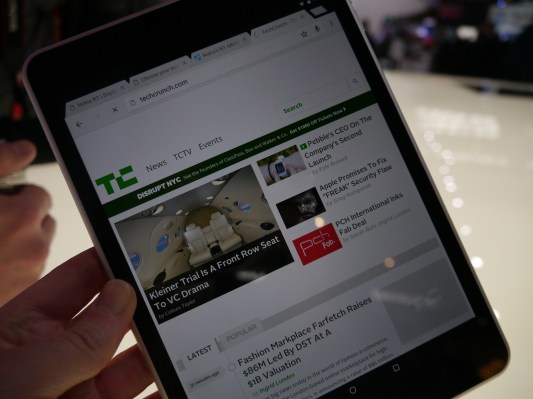Nokia is showing off the Android tablet that’s part of its post-mobile phones strategy here at Mobile World Congress in Barcelona. It’s only available in China right now but the company tells TechCrunch it’s “looking at European markets” to consider whether to bring the N1 here too.
Announced last November, the slender, almost 8-inch N1 is a brand licensing collaboration between Nokia and Chinese electronics manufacturing firm Foxconn. It’s not clear how the revenue share breaks down — and Nokia wouldn’t specify when we asked — but it’s definitely doing less of the heavy lifting, with Foxconn making the hardware and also handling distribution, sales and marketing. Nokia contributes design work, its brand name and Z Launcher Android launcher, also revealed last year.
Nokia’s Tuukka Järvenpää, lead product manager of brand licensing, said the Nokia N9 design team worked with Foxconn on the tablet’s design. The N9 was a refreshingly different, round-edged smartphone released to admiring looks back in 2011. The same design was subsequently pushed onto Nokia’s early Windows Phone devices. Nokia is now recycling some of that design language for a second time with the N1.
[gallery ids="1127334,1127332,1127333,1127330,1127329,1127331,1127326,1127327,1127328"]
In the flesh the aluminum-clad N1 tablet has a premium look and feel. Indeed, the minimalist styling could pass for Apple hardware. This is perhaps not surprising, given that Apple also uses Foxconn as a manufacturing partner. Nokia’s Järvenpää says Nokia’s aim is to create a “non-intrusive” design, which boils down to minimal hardware clutter. The tablet’s focal point is a bright and clear 2,048 x 1,536 display.
The same pared back principle extends to Nokia’s Z launcher software which sits on top of Android 5.0 (Lollipop). Järvenpää says Nokia has kept this feature-light to ensure users aren’t waiting too long for future Android updates.
The two main Z launcher features are an adaptive apps view that changes which app icons appear on your homescreen, based on your app usage; and a shortcut search that lets you scribble out the first letter of whatever you’re looking for on the homescreen and have results pulled in from across the tablet rather than having to wrangle with a full Qwerty keyboard or go hunting in the app drawer. In there, the apps are arranged alphabetically, adding to the software’s neat and tidy aura.
Both device and UI feel intentionally lightweight — and refreshingly uncluttered. And there’s no ugly looking widgets, or evidence of UI lag (during a brief hands on), as has been the case with Android tablets in years past. On the specs front, Nokia says the N1 offers a performance bump over the iOS small slate equivalent, the iPad Mini, with a quad-core chip, 2GB of RAM and 32GB of on board storage. The pricing is also aggressive, at around $250. But all that good stuff can still only entice Chinese buyers at this point.
It remains to be seen whether Nokia’s N1 tablet ends up being a China-only experiment. The version on show here in Barcelona has Google Play pre-loaded but the actual product sold in Asia comes with a Chinese app store, as is common in the market.
At this stage the N1 is evidently an experiment for Nokia as it refocuses its business after selling off its devices and services division to Microsoft last year. As part of the sale, Nokia agreed not to put its brand name on phones until 2016. But that hasn’t stopped it christening tablet hardware. And with the ban on Nokia-branded phones set to lift in a year, Nokia may well be using the N1 as a stepping stone to prepare the ground for launching a line of Android based smartphones next year, in collaboration with Foxconn.
If it is planning to bring Nokia-branded smartphones back to the market in 2016, the well-crafted, quality feel of this ‘Designed In Finland, made in China’ tablet certainly augurs well. After the moribund Windows Phone years for Nokia, this experimental new hardware direction is finally putting a spring back in its step.
